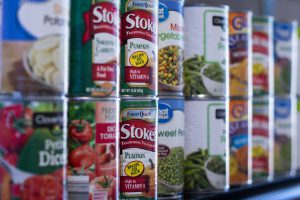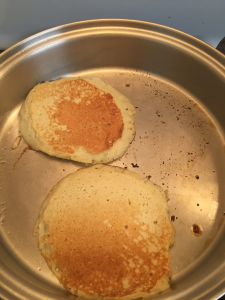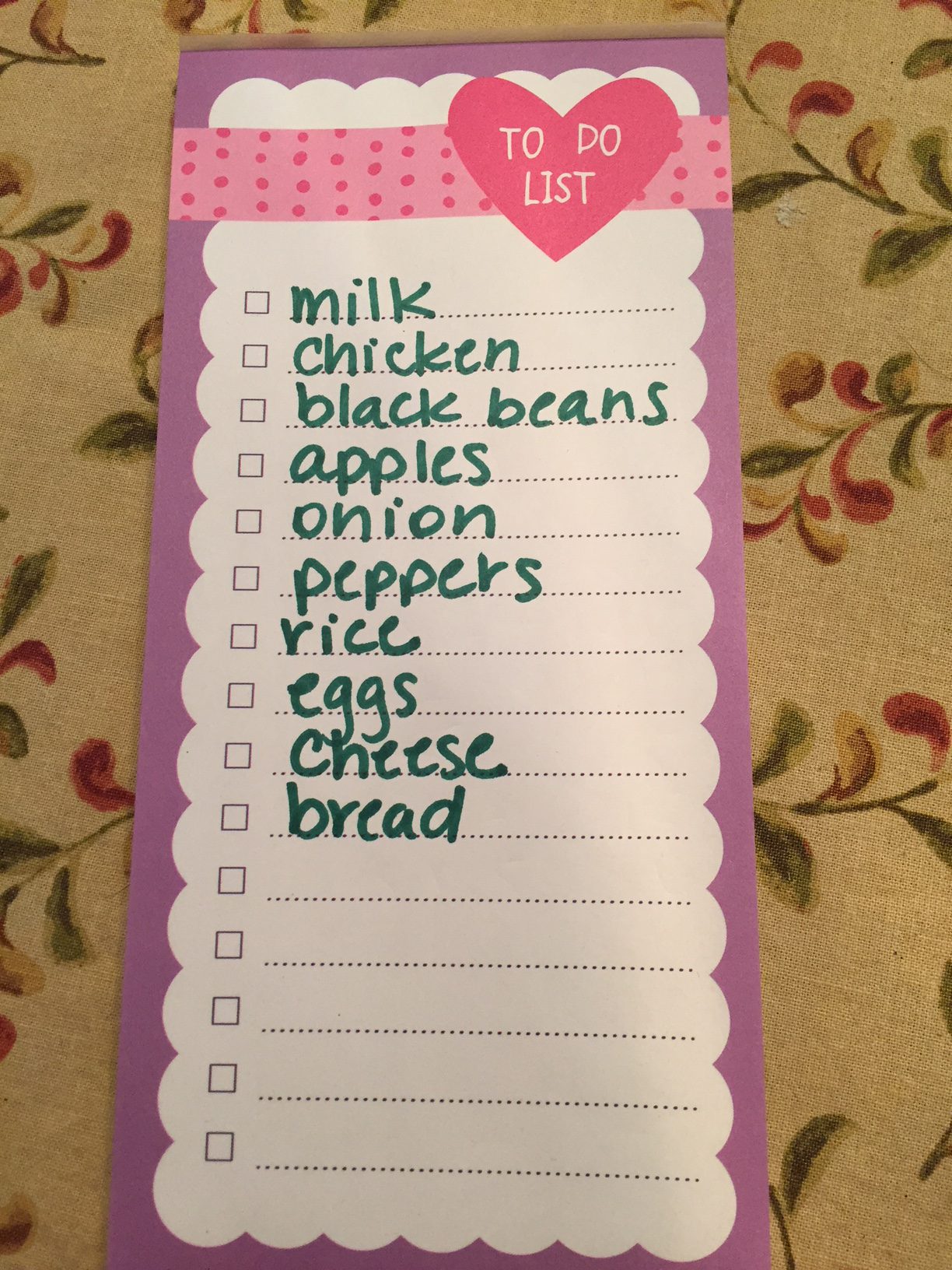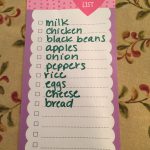
by Judy Corbus | Jul 10, 2021

Stock up on canned fruits, vegetables, meats, and heat-and-eat soups for your hurricane food supply kit. Photo source: UF/IFAS Photo by Tyler Jones.
Now that we are officially in Hurricane Season (June1-November 30) and named storms are paying a call to the Sunshine State, it’s time to make sure we are prepared.
At the top of the list is planning meals for you and your family. Many people grab snack-type foods, such as crackers, cookies, and chips, or whatever is available on store shelves when the storm is approaching without having a meal plan in mind. Use MyPlate as a guide to plan meals to include fruits, vegetables, whole grains, protein, and dairy products. Foods from each food group provide important vitamins, minerals, and other nutrients to properly fuel your body so you are better equipped to deal with the challenges and stresses that accompany hurricanes and other disasters.
Plan a two-week supply of nonperishable or canned food and juices that require little or no cooking and no refrigeration. Include healthy snacks and any special foods for infants, senior adults, or persons with specific dietary needs. Select foods your family likes and will eat. Plan meals and shop early before a storm is on the horizon so you have a greater food selection and can take advantage of sales to stock up at a reduced cost. Keep planned written menus that have worked well for you and your family inside your hurricane food supply kit in a re-sealable plastic bag.
Brenda Marty-Jimenez, Family and Consumer Sciences Agent with UF/IFAS Extension Broward County, offers the following menu suggestions:
Breakfast Ideas
Apple juice • ready-to-eat cereal • small boxes of raisins • breakfast bars with fruit • shelf-stable skim milk • tea or instant coffee • water
Orange juice • hot cereal/instant oatmeal • banana • muffin • shelf-stable skim milk • tea or instant coffee • water
Grape juice •ready-to-eat cereal • canned peaches • yogurt • bread with jam or jelly • shelf-stable skim milk • tea or instant coffee • water
Lunch Options
Chunky beef soup (ready-to-eat style that only needs heating) • crackers • carrot and celery sticks • nuts • fruit cups packed in water • vanilla wafers • shelf-stable skim milk • tea or instant coffee • water
Canned cream soup (ready-to-eat style that only needs heating) • tuna sandwich on whole-wheat bread • tomato slices • unsweetened applesauce • cookies • shelf-stable skim milk • tea or instant coffee • water
Canned chili with beans (ready-to-eat style that only needs heating) • dinner rolls with margarine or butter • broccoli florets • canned fruit • animal crackers • shelf-stable skim milk • tea or instant coffee • water
Dinner Suggestions
Canned meat or cheese ravioli • three-bean salad (canned) • fresh yellow apples • bread with margarine or butter • fat-free pudding cup • shelf-stable skim milk • tea or instant coffee • water
Egg-salad sandwich on whole-wheat bread • canned green beans • canned fruit • fat-free pudding cup • shelf-stable skim milk • tea or instant coffee • water
Mac and cheese • canned vegetable • fresh pears • dinner rolls with margarine or butter • cookies • shelf-stable skim milk • tea or instant coffee • water
Remember the four key food safety principles: Cook, Clean, Chill, and Separate.
- Use a food thermometer to check the internal temperature of cooked foods.
- Wash hands for 20 seconds with soap and water. Sanitize food preparation and cooking surfaces regularly.
- Put leftovers in sealed bags or shallow containers and pack on ice or store in the refrigerator if it is running on a generator. Dispose of food that has been at room temperature for more than two hours (one hour if the temperature is 90oF or above) or has an off-odor, color, or texture.
- Toss out food that has come in contact with contaminated flood water. Do not eat foods from dented, swollen, or corroded cans, even though the food may appear safe to eat.
For more hurricane meal planning ideas and tips, visit: http://blogs.ifas.ufl.edu/browardco/2020/06/01/hurricane-preparedness-meal-and-menu-planning/

by Kendra Hughson | Oct 21, 2019

Most foods freeze well. Pancakes are easy to make ahead and freeze for later use. Photo Credit: Kendra Zamojski
You get home after a busy day and now it’s time to figure out what to make for dinner. You open the pantry and the refrigerator in a search for something to make for dinner. Maybe you can’t find the right ingredients or you don’t feel like cooking, so you pick up the phone to order delivery. A little planning ahead, could help you save money and make healthier choices.
Meals that you can make ahead and freeze are great to have on hand for use on busy days. According to the USDA, most foods can be frozen. Canned foods and shell eggs should not be frozen. This is because liquid expands when frozen and can cause shelled eggs and metal cans or glass jars to crack or break. Instead, remove canned foods from metal cans before freezing. To freeze eggs, beat together yolk and whites for better quality; egg whites can be frozen separately. Some foods don’t freeze well like mayonnaise, cream sauces, and lettuce. These exceptions aside, make ahead meals are easy to freeze and convenient to have on hand.
Cooking ahead doesn’t need to be complicated. Start freezing leftovers for later use or try doubling recipes when you are already cooking. Soups, stews, chili, casseroles, sloppy joes, and taco filling are easy recipes to experiment with batch cooking. Freeze in airtight plastic or glass containers or freezer safe bags or packaging. If you freeze foods in glass or plastic containers, leave 1-2 inches of head space between the food and the lid to allow room for expansion. Use labels to identify the frozen products, including the date and any cooking instructions. Store food in the quantities that you want to use for later. For example, whole casseroles can be reheated for family meals or soups and stews can be stored in single-serving quantities for quick and easy lunches. Freeze quickly for the best quality and to reduce freezer burn.
When it’s time to thaw, plan ahead. Do not thaw foods on the counter. Cook frozen foods immediately after thawing. Use one of the following recommended methods:
- Refrigerator: Small quantities can thaw in the refrigerator overnight. Larger quantities may take a day or two.
- Water method: Place in a sealed, leak-proof plastic bag and submerge in cold water. Change the water every 30 minutes, until thawed.
- Microwave defrosting: Defrosting in the microwave can cause some parts of the food to start cooking. Be sure to cook foods immediately after thawing.
- Cooking from a frozen state: Casseroles and other prepared foods can be cooked from a frozen state. Plan for extra cooking time by adding 15 to 30 minutes to the cooking time. Use a food thermometer to be sure it reaches an internal temperature of 165 degrees. Never place a frozen dish in a hot, pre-heated oven.This could cause the dish to crack or break.
If you enjoy experimenting with batch cooking, there are a lot of great resources for make ahead recipes and weekly meal plans. For more information, contact your local UF/IFAS Extension office: http://sfyl.ifas.ufl.edu/find-your-local-office/
Sources:
Freezing and Food Safety: https://www.fsis.usda.gov/wps/wcm/connect/cce745c9-0fc9-4ce6-a50c-84363e5b5a48/Freezing_and_Food_Safety.pdf?MOD=AJPERES
Make Ahead Freezer Meals to the Rescue: https://extension.psu.edu/make-ahead-freezer-meals-to-the-rescue
Freezing Food for Multiple Meals: https://www.ksre.k-state.edu/humannutrition/nutrition-topics/eatingwell-budget/makeaheadmeals.html

by Kendra Hughson | Jan 19, 2018

Create a shopping list using a weekly meal plan and what you already have on hand. Photo credit: Kendra Zamojski
Grocery shopping is probably one of my least favorite weekly chores. I have a family of picky eaters and it’s difficult to find healthy meals that please everyone. I can think of a million ways I’d rather spend my time than navigating the aisles of a crowded grocery store and standing in a long check-out line surrounded by countless “closed” registers. Why aren’t there ever enough open check-out lines?
I must not be alone. I hear more and more friends choosing stores with curbside pick-up service or online grocery shopping services. Many of the major grocery store chains are testing curbside pick-up service; you’ll need to check with your local store to see if this option is available in your area. Online delivery services like Shipt and Instacart may be available if curbside service isn’t an option at your local grocery store.
If you choose to do your grocery shopping online, be sure to shop around and pay attention to and compare item prices, delivery or pick up fees, membership fees, shopper or delivery tips, and other convenience fees. Regardless of your selected service, there is an extra cost for this convenience.
No matter how you choose to buy your groceries, all of the old rules apply:
Plan your weekly meals. Write some weekly meal plans with your schedule in mind. Choose some meals using recipes that are quick and easy to prepare for busy days. Use the USDA Game Plan to help you.
Find easy to prepare, healthy recipes. Use the USDA What’s Cooking website to find healthy recipes.
Know your food budget. Planning and cooking meals at home saves money over eating out. Meals prepared at home often are healthier, especially if you are preparing recipes low in fat and sodium. Track your food dollars to see how much you are spending and saving.
Plan to use leftovers. Make double batches of soups and stews, setting aside some to freeze for later use. Freeze leftovers in single portions to use for lunch or your own ready-to-eat freezer meals throughout the week.
Pack your meals with fruits and vegetables. Plan ahead to make half of your plate fruits and vegetables. Buy fresh fruits and vegetables in season. Buying canned and frozen fruits and vegetables can save money but watch for added fat, sugar, or sodium. Bananas, carrots, greens, potatoes, and apples are low-cost options year ’round.
Create your shopping list – and stick to it! Use your meal plan to create a shopping list. Remember to check what you already have on hand. Avoid impulse items and convenience items, which can add to your food costs. A list helps you organize the items you need to buy and helps you avoid impulse buys or unneeded items that can add to your food costs.
For more information on creating healthy meals, contact your local Extension office. UF/IFAS Extension also has this great publication on Healthy Meal Plans.
by Amy Mullins, PhD, RDN | Mar 23, 2015

Prepare a shopping list
It seems that we are rushing here and there, doing things at the speed of light. We may find ourselves consumed by work, meetings, school, sports practice for the kids… an endless list of things to keep us active, stressed, and often frantic.
Life has become so busy that we often forget to take care of ourselves, which can dramatically increase the risk of preventable chronic diseases. According to the Centers for Disease Control (CDC), chronic diseases such as high blood pressure, high cholesterol, and type-2 diabetes accounted for over 26% of deaths in the United States in 2013. Chronic stress, combined with poor planning, can likely lead to unhealthy exercise and eating habits for yourself and your family.
Planning ahead is critical in side-stepping the impacts of poor nutrition and obesity-related chronic diseases.
Follow these simple tips:
- Plan meals (including brown-bag lunches and snacks) you and your family like that include lean protein, whole grains, low-fat dairy, and lots of fruits and vegetables.
- Save time and money by making a grocery list before going to the store.
- Be a master planner! Save your weekly meal plans and grocery lists to use again another week.
- Avoid take-out and make foods that you can bring to work the next day for lunch.
- Avoid the vending machine and bring snacks to work like nuts, fresh or dried fruit, or whole-grain crackers and hummus.
- Don’t forget to eat breakfast! A quick bowl of cereal with low-fat milk and a small cup of orange juice can help you make it to lunchtime.
- Carry a tumbler! Fill up on water all day, anywhere and everywhere, to keep you hydrated and help you to avoid sugary drinks and sodas.
Make sure to plan time each day to be active. Taking short walks and stretching at your desk can make a world of difference in your health and attitude. For additional information on healthy eating, please visit ChooseMyPlate.gov and Nutrition.gov.







